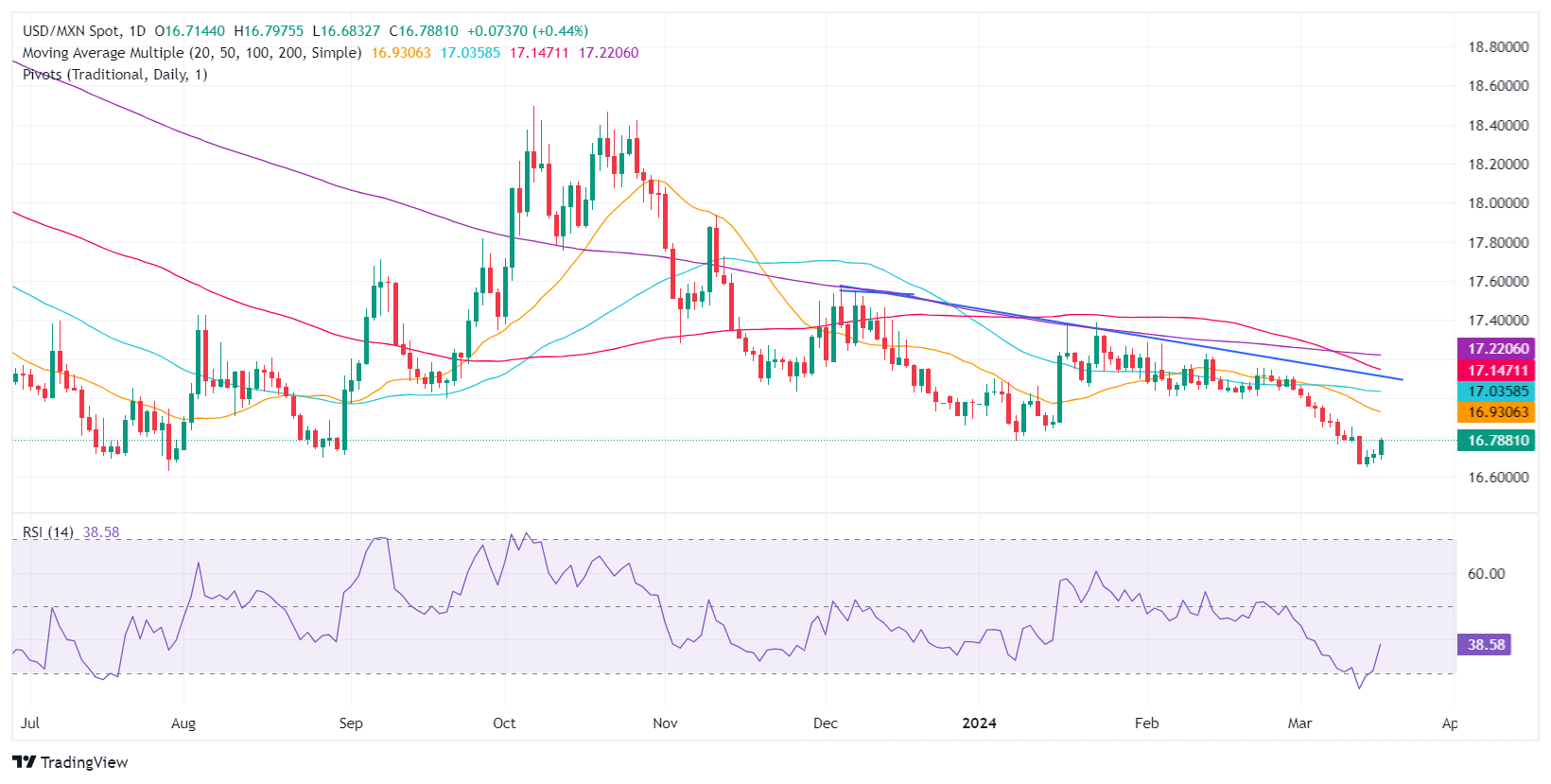Mexican Peso plummets amid Fed’s hawkish tilt speculation

- Mexican Peso depreciates as local markets close for Benito Juarez’s birthday, USD/MXN aiming above 16.80.
- Banxico is widely anticipated to reduce interest rates slightly amidst a focus on upcoming US economic data and the FOMC outcome.
- Attention turns to key economic reports and central bank decisions in Mexico and the US this week.
The Mexican Peso (MXN) depreciates sharply against the US Dollar (USD) on Monday as Mexico’s markets remain closed in the observance of Benito Juarez’s birth, a former President of Mexico. A busy economic week with both US Federal Reserve (Fed) and Bank of Mexico (Banxico) monetary policy decisions will be the main driver of price action. The USD/MXN trades at 16.82, up 0.72% near new three-day high.
Mexico’s economic docket will remain empty during the first day of the week but gather attention on Tuesday. The docket will feature Aggregate Demand and Private Spending. On Thursday, the schedule will feature the release of Retail Sales data for January, which are expected to recover, followed by Banxico’s decision. Most investors expect Mexico’s central bank to cut borrowing costs from 11.25% to 11% on March 21.
On the other side of the border, US housing data could influence the Greenback’s price ahead of the Federal Open Market Committee (FOMC) decision. Market participants will be looking for any adjustments to the statement, the Summary of Economic Projections (SEP), and Fed Chairman Jerome Powell’s press conference.
Daily digest market movers: Mexican Peso on defensive amid dovish Banxico
- The USD/MXN is being driven by the reduction of interest rate spreads between Mexico and the United States. This could bolster and set the USD/MXN direction toward the 17.00 figure.
- On March 21, Banxico is expected to decrease interest rates, even though it could feature a 3-2 vote split. Recent speeches and media appearances show that Banxico’s Governing Council is divided, with Governor Victoria Rodriguez Ceja, Omar Mejia Castelazo and Galia Borja Gomez leaning dovish. On the hawkish front lie Jonathan Heath and Irene Espinosa Cantellano.
- An economic slowdown in Mexico is the main event that could spark Banxico’s first rate cut as the central bank has adjusted its economic projections to the downside. Mexico’s central bank expects the economy to grow 2.8% YoY in 2024, down from 3% and maintaining at 1.5% for 2025.
- Banxico’s private poll in February showed that analysts project inflation to slow down, which could spark the central bank’s first rate cut. They see interest rates at 9.5% and the exchange rate at 18.31 towards the year-end.
- The latest inflation figures in the United States prompted investors to price in a less dovish stance. Money market futures had adjusted their rate cut expectations more in line with the Fed as they foresee the Federal Funds Rate (FFR) at 4.71% toward year end. The next Fed meeting is scheduled for March 19-20 next week.
- The CME FedWatch Tool shows traders decreasing their bets on a 25-basis-point rate cut in June, down from 72% at the beginning of last week to 58% as of writing.
Technical analysis: Mexican Peso begins to weaken as USD/MXN aims toward 16.80
The USD/MXN is at the brisk of shifting neutral bias as buyers had stepped in at around the lows of the year and lifted the exchange rate near the 16.80 area. A breach of the latter could push the pair toward the 17.00 figure. Once surpassed, the next stop would be the 50-day Simple Moving Average (SMA) at 17.02, followed by the 100-day SMA at 17.16 and the 200-day SMA at 17.21.
On the flip side, if the pair stays below 16.80, that could pave the way for a test of last year’s low of 16.62, followed by October 2015’s low of 16.32 and the 16.00 psychological level.
USD/MXN Price Action – Daily Chart
Fed FAQs
Monetary policy in the US is shaped by the Federal Reserve (Fed). The Fed has two mandates: to achieve price stability and foster full employment. Its primary tool to achieve these goals is by adjusting interest rates. When prices are rising too quickly and inflation is above the Fed’s 2% target, it raises interest rates, increasing borrowing costs throughout the economy. This results in a stronger US Dollar (USD) as it makes the US a more attractive place for international investors to park their money. When inflation falls below 2% or the Unemployment Rate is too high, the Fed may lower interest rates to encourage borrowing, which weighs on the Greenback.
The Federal Reserve (Fed) holds eight policy meetings a year, where the Federal Open Market Committee (FOMC) assesses economic conditions and makes monetary policy decisions. The FOMC is attended by twelve Fed officials – the seven members of the Board of Governors, the president of the Federal Reserve Bank of New York, and four of the remaining eleven regional Reserve Bank presidents, who serve one-year terms on a rotating basis.
In extreme situations, the Federal Reserve may resort to a policy named Quantitative Easing (QE). QE is the process by which the Fed substantially increases the flow of credit in a stuck financial system. It is a non-standard policy measure used during crises or when inflation is extremely low. It was the Fed’s weapon of choice during the Great Financial Crisis in 2008. It involves the Fed printing more Dollars and using them to buy high grade bonds from financial institutions. QE usually weakens the US Dollar.
Quantitative tightening (QT) is the reverse process of QE, whereby the Federal Reserve stops buying bonds from financial institutions and does not reinvest the principal from the bonds it holds maturing, to purchase new bonds. It is usually positive for the value of the US Dollar.
